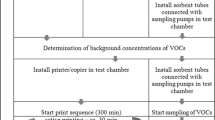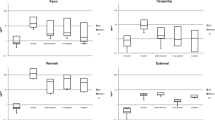Abstract
The use of inks containing organic solvents by the offset printing process implies in the release of volatile organic compounds to the work environment. Many of these compounds such as benzene, toluene, ethylbenzene, and the xylene isomers (well known by the acronym BTEX) are extremely toxic. In this study, the BTEX concentrations were determined in two different printing plants that use distinct types of inks: the conventional and the so-called ecological, which is manufactured based on vegetal oil. Concentration ranges were 43–84, 15–3,480, 2–133, 5–459, and 2–236 μg m−3 for benzene, toluene, ethylbenzene, m + p-xylene, and o-xylene, respectively, for the conventional printing plant. At the ecological printing plant, concentration ranges were below limit of detection (<LD)-31, <LD-618, <LD-1,690, <LD-10,500, <LD-3,360 μg m−3 for benzene, toluene, ethylbenzene, m + p-xylene, and o-xylene, respectively. BTEX concentrations are lower at the ecological printing environment than in the conventional, where mineral oil-based inks are used. However, the worker who cleans the printing matrices is exposed to high concentrations of ethylbenzene and xylenes, due probably to the cleaning product’s composition (containing high amounts of BTEX). Although the BTEX concentrations found in both printing work environments were below the limits considered by the Brazilian Law for Activities and Unhealthy Operations (NR-15), the exposure to such vapors characterizes risk to the workers’ health for some of the evaluated samples, mainly the personal ones.

Similar content being viewed by others
References
Aquino Neto, F. R., & Gioda, A. (2002). Chemical pollution related to the indoor air in Brazil. Química Nova, 26(3), 359–365. Portuguese.
ASA, American Soybean Association. (2008). Soyseal user agreement. United States. http://www.soygrowers.com/resources/soyink.htm. Assessed 4 April 2008.
Cocheo, V., Boaretto, C., & Sacco, P. (1996). High uptake rate radial diffusive sampler suitable for both solvent and thermal desorption. American Industrial Hygiene Association Journal, 57, 897–904.
Hinwood, A. L., Berko, H. N., Farrar, D., Galbally, I. E., & Weeks, I. A. (2006). Volatile organic compounds in selected micro-environments. Chemosphere, 63, 421–429.
HSDB. (2008). Hazardous substances data bank. <http://toxnet.nlm.nih.gov>, June 22, 2009.
INSHT—Instituto Nacional de Seguridad y Higiene en el Trabajo. (2001). Limites de exposición profesional para agentes químicos em España, 2001. http://www.mtas.es/insht/revista/A_18_ST01>htm. Assessed 3 April 2007.
Jo, W., & Moon, K. (1999). Housewive’s exposure to volatile organic compounds relative to proximity to roadside service stations. Atmospheric Environment, 33, 2921–2928.
Lataye, R., Campo, P., Pouyatos, B., Cossec, B., Blachere, V., & Morel, G. (2003). Solvent ototoxicity in the rat and guinea pig. Neurotoxicology and Teratology, 25, 39–50.
Lee, S. C., Li, W. M., & Ao, C. H. (2002). Investigation of indoor air quality at residential homes in Hong Kong—case study. Atmospheric Environment, 36, 225–237.
Leung, K. H., Liu, C.-H., & Chan, A. H. S. (2005). Occupational exposure to volatile organic compounds and mitigation by push–pull local exhaust ventilation in printing plants. Journal of Occupational Health, 45, 540–547.
Morata, T. C., Fiorini, A. C., Fischer, F. M., Colacioppo, S., Wallingford, K. M. M., & Krieg, E. F. (1997). Toluene-induced hearing loss among rotogravure printing workers. Scandinavian Journal of Work, Environment & Health, 23(4), 289–298.
NIOSH. (2007). NIOSH pocket guide to chemical hazards, publication no. 2005–149. Cincinnati: NIOSH.
NSIIC—National Soy Ink Information Center. (2009). http://www.soyink.com, June 25, 2009.
Pariselli, F., Sacco, M. G., Ponti, J., & Rembges, D. (2009). Effects of toluene and benzene air mixtures on human lung cells (A549). Experimental and Toxicologic Pathology, 61, 381–386.
Potgieter-Vermaak, S., Stranger, M., Godoi, A. F. L., Jacobs, W., Godoi, R. H. M., & Van Grieken, R. (2008). Volatile organic gaseous pollutants in various indoor environments. In S. A. Lynch & L. K. Moore (Eds.), Air quality—new research (Vol. 1, pp. 1–30). New York: Nova Science.
Simpson, B., Tazik, P., Moleiro, G., Randall, P. (1994). Waste reduction evaluation of soy-based ink at sheet-fed offset printer. U.S. Environmental Protection Agency, Cincinnati, OH, USA.
Silva, L. I. B., Rocha-Santos, T. A. P., & Duarte, A. C. (2009). Remote optical fibre microsensor for monitoring BTEX in confined industrial atmospheres. Talanta, 78(2), 548–552.
Solomon, S. J., Schade, G. W., Kuttippurath, J., Ladstätter-Weissenmayer, A., & Burrows, J. P. (2008). VOC concentrations in an indoor workplace environment of a university building. Indoor and Built Environment, 17(3), 260–268.
Zjakic, I., Bolanca, S., Bolanca, Z. (2002). The colour characteristics of modern printing. The First European Conference on Color in Graphics, Imaging and Vision (CGIV), Poitiers, France; pp. 545–548.
Acknowledgment
The authors would like to thank the managers and workers of both printing plants for the cooperation and help with the measurements.
Author information
Authors and Affiliations
Corresponding author
Rights and permissions
About this article
Cite this article
Godoi, A.F.L., Sawada, E.Y., de Marchi, M.R.R. et al. Determination of BTEX by GC–MS in Air of Offset Printing Plants: Comparison between Conventional and Ecological Inks. Water Air Soil Pollut: Focus 9, 163–169 (2009). https://doi.org/10.1007/s11267-009-9219-9
Received:
Accepted:
Published:
Issue Date:
DOI: https://doi.org/10.1007/s11267-009-9219-9




